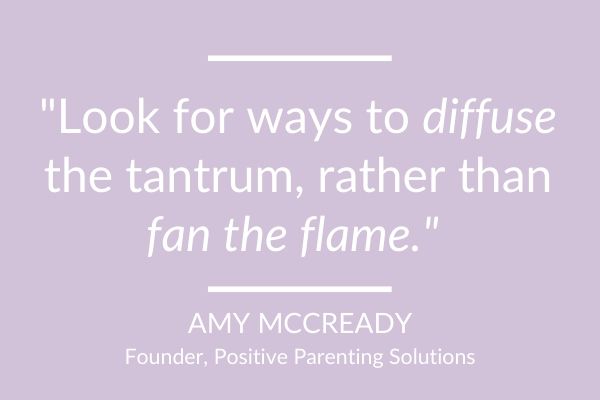4 Strategies for Dealing with Tantrums in Public

It’s an hour past your son’s bedtime, but sleep is the furthest thing from his mind as he throws his little body onto his bedroom floor. All he wanted was just one more sip of water.
He screams, he cries, he shouts. It’s nothing you haven’t been through before, but it hurts nonetheless. No one likes a temper tantrum.
You stand idly by, utterly exhausted, and think, “Is there anything on earth worse than this right here?”
Of course, you know the answer.
Yes. There is indeed something worse. After all, you could have an audience.
I’m talking about public temper tantrums.
I’m sure you can just imagine it now. The snickering, the finger-pointing, the staring. Public tantrums are uncomfortable, awkward, and downright humiliating. But more than anything–they’re common!
In fact, you’d be hard-pressed to find an experienced parent who hasn’t had at least one mortifying tale to tell when it comes to their little one breaking down in the middle of a crowded place. So take comfort in knowing that you are most certainly not alone.
Still, just because they do happen doesn’t mean they have to happen. Because going out in public with your child should not be something you dread.
Tantrum Prevention
Naturally, stopping a tantrum from happening in the first place is much more ideal than having to deal with one once it’s already begun. You know your child better than anyone else; what makes him tick and what sets him off. Now is the time to be proactive! Try and avoid a tantrum all together by taking charge and thinking ahead before ever stepping foot outside your house.
Of course, even with the best preparation, sometimes tantrums are simply unavoidable. Even in public places. When that happens, it’s time to go to the next best option…
Tantrum Diffusion
In a perfect world, our children would behave like angels any time we went out in public. There would be no need to worry about last-minute trips to the grocery store or play dates that extend into naptime.
But that’s not reality, is it?
Tantrums happen and, all too often, they happen in public. When they do, you may be tempted to yell, threaten, or cry yourself–but don’t! Instead, look for ways to diffuse the tantrum rather than fan the flame.

Here are 4 strategies you can use for dealing with tantrums in public.
Strategy #1: Be Prepared
When it comes to doing anything with children–especially going out in public–preparation is key.
Before leaving your house, make a mental checklist of where you will be going and what issues could possibly arise to trigger a tantrum–then prepare for them!
Does your grocery trip set off a tantrum each time you pass the toy aisle and not allow your son to buy a new Hot Wheel? Is your doctor’s appointment right across the street from your daughter’s favorite ice cream shop?
When tantrums start to arise, distraction is key. Having a few small games, coloring books, or toys on hand can help keep your child’s mind busy and a tantrum at bay.
Not sure what toys would be best to bring along? Aim for sensory toys! Not only do kids find them enjoyable to play with, but they are stimulating enough to help develop their fine and gross motor skills. Textured balls and shaker eggs are perfect for keeping your younger toddlers and babies occupied, while fidget spinners and silly putty are great for older kids.
It’s also equally important to prepare yourself mentally. Despite your best efforts, a public tantrum may still happen. If it does, set your intentions clearly beforehand: You are not going to worry about the judgment of others. Instead, you will focus on the needs of your child and the situation.
Knowing and accepting that a tantrum may still happen will help you remain calm and respond to the situation appropriately.
Strategy #2: Give Them a Job
You’ve tried and tried to put it off as long as you could, but your empty pantry and barren refrigerator seem to be screaming at you, “It’s time to go grocery shopping!”
And if that’s not enough, you have to bring along your four-year-old daughter, which makes the task so much more daunting. After all, her attention span is incredibly short and you’re looking at a minimum hour-long shopping trip. From experience, you know a public tantrum is likely.
You could just stay home. That half sleeve of saltines should be enough to live off of for the foreseeable future, right?
OR, you could confidently go to the store…and give your daughter a job.
Who says grocery shopping has to be a chore?
Why not make it a fun experience by coming up with a grocery store scavenger hunt? Armed with a clipboard, crayon, and your grocery list, find fun ways to incorporate what items you need with scavenger hunt items she must find.
Need to make a trip down the cereal aisle? Send her on the hunt for brands that start with the letter C. Looking for some fresh produce? How many green vegetables can she find? Not only will this game give her a boost of positive power from helping you do the shopping, but it should also be enough to keep her entertained for the entirety of the trip.
Strategy #3: Control Your Reaction
As a parent, your reaction to your child’s tantrum can be a force for good or evil. I’m kidding, of course, but there is a fine line between overreacting and not reacting at all.
On the one hand, an overreaction on your part could prove to your child that he can successfully push your buttons by acting out in public, thus giving him a reason to continue the negative behavior in the future. However, not reacting at all and ignoring your child’s tantrum may not be wise if he truly does need your help in working through his big emotions.
Like I said, it’s a delicate line to toe.
In order to make sure your reaction is spot on, it’s important to understand that there are two types of tantrums: upstairs (manipulative) and downstairs (meltdowns).
According to Dr. Daniel Siegel, co-author of The Whole-Brain Child, Upstairs tantrums come from the more highly developed “upstairs” part of the brain used for logical thinking, regulating emotions and evaluating consequences.
With this type of tantrum, the child makes a conscious decision to act out and push the limits to get her way, and can also decide to stop acting out as soon as you give in to her demands. Simply put, these tantrums are designed to manipulate you.
With an upstairs tantrum it is best to simply not react so he doesn’t get a power payoff from acting out. Remove yourself from the situation–no eye contact, no talking down, and no negotiating.
Downstairs tantrums deal with what Positive Parenting Solutions calls “meltdown” tantrums. These tantrums are controlled by the downstairs part of a child’s brain, which handles such tasks as breathing, blinking, and instinctual reactions. In this type of tantrum, the child has been pushed beyond his physical or emotional limit and “melts down” as a result.
Here the child is so upset he can no longer access his higher-level “upstairs” thinking, such as using any form of logic. Which explains why telling him “the blue plate is in the dishwasher” gets you nowhere when he’s tired and hungry after a morning of errands.
Your reaction to a downstairs tantrum is equally as important as your lack of a reaction to an upstairs tantrum. Here is where your child needs you to help him calm his big emotions while you make a mental note that you’ll want to do some training on managing overwhelming feelings in the future.
Note: For Positive Parenting Solutions Members, review Session 4 for more information on how to handle tantrums of any kind, at any place, and for any age!
Strategy #4: Change the Scenery
After a long morning spent running errands around town, you decide to treat your two-year-old to a Happy Meal and a trip to the play place. After all, he did so well behaving all morning.
Once the nuggets are eaten and the restaurant starts to quiet, you look down at your watch. It’s naptime.
You walk over to your son, happily playing in the ball pit and say, “Time to get out, sweetie. We need to go home for a nap.”
Suddenly, the sweet little boy you’ve known all morning is nowhere to be seen. His face squinches in rage as he starts to scream in protest. Before you know it, balls are being thrown, tears are being shed, and a full-on public temper tantrum has begun.
You can feel the other parents in the room staring at you. Some offer a nod of condolence–surely they’ve been in your shoes before–but most just stare, making you feel like an ant under a magnifying glass.
With the tantrum in full-swing and your anxiety rising by the second, the best thing you can do in the moment is to change the scenery. Find someplace in the area more private–perhaps the bathroom or your car outside–and remove both yourself and your son from the room.
While it can be embarrassing walking away with a thrashing toddler hoisted over your shoulder, finding a more private place to deal with the tantrum will help calm your nerves and allow you to focus on helping your son without the distraction of an audience.
Final Thoughts
No matter who you are or how long you’ve been a parent, dealing with your child’s temper tantrums in public is never easy.
We’ve all been there–fighting through the embarrassment, anger, sadness, and utter desperation that pops up when it seems as though all the world’s judgment is focused squarely on us. But there is help!
Not only can we help you find ways to stop tantrums before they’ve begun, but the Positive Parenting Solutions course is also filled with useful tools and strategies to help you deal with temper tantrums of every kind, in every place, with every age.
Feel free to give us test us a test run first by JOINING ME FOR A FREE ONLINE CLASS where I’ll teach you how to get your kids to listen–no nagging, yelling, or reminding required.
I assure you, no tantrum is too big to handle. Especially when you’ve got the right tools in your belt and the right support to help you every step of the way.
Title Image: Lolostock / Shutterstock https://www.shutterstock.com/photos
What You Should Do Next:
1. Subscribe to my Newsletter:
Sign up for my newsletter for parenting tips to help you create a happier home and become the parent you always wanted to be. Plus, when you subscribe, I'll also send you a copy of our strategy-packed guide 10 Tips for Better Behavior – Starting NOW!
2. Register for my FREE 60-Minute Class:
Register for my free class called How to Get Kids to Listen, Without Nagging, Yelling or Losing Control. Classes run several times per week to accommodate your busy schedule.
3. Enroll in my 7-Step Parenting Success System® Course
Enroll now in my proven 7-step system for busy parents ready for change (it's rated 5 stars on Google). Plus, for a limited time, save $100 on all plans—completely risk-free and with lifetime access.
About the Author





